Raman-Activated Cell Ejection for Validating the Reliability of the Raman Fingerprint Database of Foodborne Pathogens
Abstract
1. Introduction
2. Material and Methods
2.1. Bacterial Culture and Sample Preparation
2.2. Single-Cell Raman Spectra Acquisition
2.3. Data Preprocessing and Analysis
2.4. Identification and Ejection of Bacteria with Unknown Tags
2.5. Amplification of Genomic DNA and Sequencing
3. Results and Discussion
3.1. SCRS of Foodborne Pathogens
3.2. Classification Models for Recognition of Foodborne Pathogens
3.3. Examination of Single Cells’ Sorting Efficiency
3.4. Recognition of Target Bacteria through RACE
4. Conclusions
Supplementary Materials
Author Contributions
Funding
Institutional Review Board Statement
Informed Consent Statement
Data Availability Statement
Conflicts of Interest
References
- Younes, N.; Yassine, H.M.; Kourentzi, K.; Tang, P.; Litvinov, D.; Willson, R.C.; Abu-Raddad, L.J.; Nasrallah, G.K. A review of rapid food safety testing: Using lateral flow assay platform to detect foodborne pathogens. Crit. Rev. Food Sci. Nutr. 2023, 1–23. [Google Scholar] [CrossRef] [PubMed]
- Tao, Q.; Wu, Q.; Zhang, Z.H.; Liu, J.; Tian, C.F.; Huang, Z.H.; Malakar, P.K.; Pan, Y.J.; Zhao, Y. Meta-analysis for the global prevalence of foodborne pathogens exhibiting antibiotic resistance and biofilm formation. Front. Microbiol. 2022, 13, 906490. [Google Scholar] [CrossRef]
- Escobar, V.; Scaramozzino, N.; Vidic, J.; Buhot, A.; Mathey, R.; Chaix, C.; Hou, Y.X. Recent advances on peptide-based biosensors and electronic noses for foodborne pathogen detection. Biosensors 2023, 13, 258. [Google Scholar] [CrossRef]
- Song, Y.; Li, W.Q.; Xu, H.Y. Recent advances and trends in aptasensors for sensitive detection of foodborne pathogens in various foods. TrAC Trends Anal. Chem. 2023, 167, 117268. [Google Scholar] [CrossRef]
- Jayan, H.; Pu, H.B.; Sun, D.W. Recent developments in Raman spectral analysis of microbial single cells: Techniques and applications. Crit. Rev. Food Sci. Nutr. 2022, 62, 4294–4308. [Google Scholar] [CrossRef]
- He, Y.H.; Wang, X.X.; Ma, B.; Xu, J. Ramanome technology platform for label-free screening and sorting of microbial cell factories at single-cell resolution. Biotechnol. Adv. 2019, 37, 107388. [Google Scholar] [CrossRef]
- Xu, J.B.; Luo, Y.J.; Wang, J.K.; Tu, W.M.; Yi, X.F.; Xu, X.G.; Song, Y.Z.; Tang, Y.G.; Hua, X.T.; Yu, Y.S.; et al. Artificial intelligence-aided rapid and accurate identification of clinical fungal infections by single-cell Raman spectroscopy. Front. Microbiol. 2023, 14, 1125676. [Google Scholar] [CrossRef] [PubMed]
- Wang, Y.; Xu, J.B.; Cui, D.Y.; Kong, L.C.; Chen, S.Z.; Xie, W.; Zhang, C.L. Classification and identification of archaea using single-cell Raman ejection and artificial intelligence: Implications for investigating uncultivated microorganisms. Anal. Chem. 2021, 93, 17012–17019. [Google Scholar] [CrossRef] [PubMed]
- Liu, B.; Liu, K.X.; Wang, N.; Ta, K.W.; Liang, P.; Yin, H.B.; Li, B. Laser tweezers Raman spectroscopy combined with deep learning to classify marine bacteria. Talanta 2022, 244, 123383. [Google Scholar] [CrossRef]
- Hsu, C.C.; Xu, J.B.; Brinkhof, B.; Wang, H.; Cui, Z.F.; Huang, W.E.; Ye, H. A single-cell Raman-based platform to identify developmental stages of human pluripotent stem cell-derived neurons. Proc. Natl. Acad. Sci. USA 2020, 117, 18412–18423. [Google Scholar] [CrossRef]
- Wichmann, C.; Dengler, J.; Hoffmann, M.; Rösch, P.; Popp, J. Simulating a reference medium for determining bacterial growth in hospital wastewater for Raman spectroscopic investigation. Spectrochim. Acta A 2024, 305, 123425. [Google Scholar] [CrossRef] [PubMed]
- Yan, S.S.; Wang, S.Y.; Qiu, J.X.; Li, M.H.; Li, D.Z.; Xu, D.P.; Li, D.X.; Liu, Q. Raman spectroscopy combined with machine learning for rapid detection of food-borne pathogens at the single-cell level. Talanta 2021, 226, 122195. [Google Scholar] [CrossRef] [PubMed]
- Wang, Y.; Xu, J.B.; Kong, L.C.; Liu, T.; Yi, L.B.; Wang, H.J.; Huang, W.E.; Zheng, C.M. Raman-deuterium isotope probing to study metabolic activities of single bacterial cells in human intestinal microbiota. Microb. Biotechnol. 2020, 13, 572–583. [Google Scholar] [CrossRef] [PubMed]
- Hanson, C.; Bishop, M.M.; Barney, J.T.; Vargis, E. Effect of growth media and phase on Raman spectra and discrimination of mycobacteria. J. Biophotonics 2019, 12, e201900150. [Google Scholar] [CrossRef]
- Gonzalez-Gonzalez, C.R.; Hansen, M.; Stratakos, A.C. Rapid identification of foodborne pathogens in limited resources settings using a handheld Raman spectroscopy device. Appl. Sci. 2022, 12, 9909. [Google Scholar] [CrossRef]
- Yan, S.S.; Qiu, J.X.; Guo, L.; Li, D.Z.; Xu, D.P.; Liu, Q. Development overview of Raman-activated cell sorting devoted to bacterial detection at single-cell level. Appl. Microbiol. Biotechnol. 2021, 105, 1315–1331. [Google Scholar] [CrossRef] [PubMed]
- Wang, Y.; Ji, Y.T.; Wharfe, E.S.; Meadows, R.S.; March, P.; Goodacre, R.; Xu, J.; Huang, W.E. Raman activated cell ejection for isolation of single cells. Anal. Chem. 2013, 85, 10697–10701. [Google Scholar] [CrossRef] [PubMed]
- Li, J.B.; Zhang, D.Y.; Luo, C.L.; Li, B.; Zhang, G. In situ discrimination and cultivation of active degraders in soils by genome-directed cultivation assisted by SIP-Raman-activated cell sorting. Environ. Sci. Technol. 2023, 57, 17087–17098. [Google Scholar] [CrossRef]
- Jing, X.Y.; Gou, H.L.; Gong, Y.H.; Su, X.L.; Xu, L.; Ji, Y.T.; Song, Y.Z.; Thompson, L.P.; Xu, J.; Huang, W.E. Raman-activated cell sorting and metagenomic sequencing revealing carbon-fixing bacteria in the ocean. Environ. Microbiol. 2018, 20, 2241–2255. [Google Scholar] [CrossRef]
- Wang, Y.; Xu, J.B.; Kong, L.C.; Li, B.; Li, H.; Huang, W.E.; Zheng, C.M. Raman-activated sorting of antibiotic-resistant bacteria in human gut microbiota. Environ. Microbiol. 2020, 22, 2613–2624. [Google Scholar] [CrossRef]
- Poth, M.; Magill, G.; Filgertshofer, A.; Popp, O.; Grosskopf, T. Extensive evaluation of machine learning models and data preprocessings for Raman modeling in bioprocessing. J. Raman Spectrosc. 2022, 53, 1580–1591. [Google Scholar] [CrossRef]
- Liu, Z.Y.; Xue, Y.; Yang, C.; Li, B.; Zhang, Y. Rapid identification and drug resistance screening of respiratory pathogens based on single-cell Raman spectroscopy. Front. Microbiol. 2023, 14, 1065173. [Google Scholar] [CrossRef] [PubMed]
- Wang, J.K.; Meng, S.Y.; Lin, K.C.; Yi, X.F.; Sun, Y.X.; Xu, X.G.; He, N.; Zhang, Z.Q. Leveraging single-cell Raman spectroscopy and single-cell sorting for the detection and identification of yeast infections. Anal. Chim. Acta 2023, 1239, 340658. [Google Scholar] [CrossRef] [PubMed]
- Yang, B.; Zhu, D.D.; Chen, Y.P.; Xu, Y.; Yang, Y.J.; Zeng, J.Q.; Ye, L.; He, M.; Jia, X.B.; Feng, L. Corn silk extract alleviate type 1 diabetes via regulating gut microbiota and inflammation. J. Funct. Foods 2024, 112, 105969. [Google Scholar] [CrossRef]
- Qin, H.; Zhang, S.Y.; Wang, C.; Pan, Q.L.; Dong, Y.; Cai, X.B.; Wang, X.J.; Huang, M.Y.; Huang, J.; Zhou, R.Q. Revealing the influence of exogenously inoculated Bacillus spp. on the microbiota and metabolic potential of medium-temperature Daqu: A meta-omics analysis. Food Res. Int. 2024, 182, 14152. [Google Scholar] [CrossRef] [PubMed]
- Hu, H.J.; Wang, J.K.; Yi, X.F.; Lin, K.C.; Meng, S.Y.; Zhang, X.; Jiang, C.Y.; Tang, Y.G.; Wang, M.G.; He, J.; et al. Stain-free Gram staining classification of pathogens via single-cell Raman spectroscopy combined with machine learning. Anal. Methods 2022, 14, 4014–4020. [Google Scholar] [CrossRef]
- Lu, W.L.; Li, H.F.; Qiu, H.N.; Wang, L.; Feng, J.; Fu, Y.V. Identification of pathogens and detection of antibiotic susceptibility at single-cell resolution by Raman spectroscopy combined with machine learning. Front. Microbiol. 2023, 13, 1076965. [Google Scholar] [CrossRef] [PubMed]
- Yang, B.; Chen, C.; Chen, F.F.; Ma, C.L.; Chen, C.; Zhang, H.T.; Gao, R.; Zhang, S.L.; Lv, X.Y. Feature fusion combined with tissue Raman spectroscopy to screen cervical cancer. J. Raman Spectrosc. 2021, 52, 1830–1837. [Google Scholar] [CrossRef]
- Russell, A.D. Bacterial resistance to disinfectants: Present knowledge and future problems. J. Hosp. Infect. 1999, 43, S57–S68. [Google Scholar] [CrossRef]
- Yuan, X.F.; Song, Y.Q.; Song, Y.Z.; Xu, J.B.; Wu, Y.H.; Glidle, A.; Cusack, M.; Ijaz, U.Z.; Cooper, J.M.; Huang, W.E.; et al. Effect of laser irradiation on cell function and its implications in Raman spectroscopy. Appl. Environ. Microbiol. 2018, 84, e0250817. [Google Scholar] [CrossRef]
- Sun, Y.; Fu, X.; Li, Y.L.; Yuan, Q.Q.; Ou, Z.Y.; Lindgren, T.; Deng, Y.Q.; Norbäck, D. Shotgun metagenomics of dust microbiome from flight deck and cabin in civil aviation aircraft. Indoor Air 2020, 30, 1199–1212. [Google Scholar] [CrossRef]
- Li, Z.M.; Xia, J.J.; Jiang, L.Y.Q.; Tan, Y.M.; An, Y.T.; Zhu, X.Y.; Ruan, J.; Chen, Z.H.; Zhen, H.F.; Ma, Y.Y.; et al. Characterization of the human skin resistome and identification of two microbiota cutotypes. Microbiome 2021, 9, 47. [Google Scholar] [CrossRef]
- Zhu, M.H.; Zhu, Q.; Yang, Z.; Liang, Z.X. Clinical characteristics of patients with micrococcus luteus bloodstream infection in a Chinese tertiary-care hospital. Pol. J. Microbiol. 2021, 70, 321–326. [Google Scholar] [CrossRef]
- Sobol, M.S.; Kaster, A.K. Back to basics: A simplified improvement to multiple displacement amplification for microbial single-cell genomics. Int. J. Mol. Sci. 2023, 24, 4270. [Google Scholar] [CrossRef]
- Hill, I.E.; Boyd, M.; Milligan, K.; Jenkins, C.A.; Sorensen, A.; Jirasek, A.; Graham, D.; Faulds, K. Understanding radiation response and cell cycle variation in brain tumour cells using Raman spectroscopy. Analyst 2023, 148, 2594–2608. [Google Scholar] [CrossRef] [PubMed]
- Edengeiser, E.; Meister, K.; Bründermann, E.; Büning, S.; Ebbinghausa, S.; Havenitha, M. Non-invasive chemical assessment of living human spermatozoa. RSC Adv. 2015, 5, 10424–10429. [Google Scholar] [CrossRef]
- Su, X.L.; Gong, Y.H.; Gou, H.L.; Jing, X.Y.; Xu, T.; Zheng, X.S.; Chen, R.Z.; Li, Y.D.; Ji, Y.T.; Ma, B.; et al. Rational optimization of Raman-activated cell ejection and sequencing for bacteria. Anal. Chem. 2020, 92, 8081–8089. [Google Scholar] [CrossRef] [PubMed]
- Zhang, Y.F.; Qiao, D.; Shi, W.Y.; Wu, D.N.; Cai, M. Capnocytophaga periodontitidis sp. nov., isolated from subgingival plaque of periodontitis patient. Int. J. Syst. Evol. Microbiol. 2021, 71, 004979. [Google Scholar] [CrossRef] [PubMed]
- Jaeckle, E.; Brauchle, E.; Nottrodt, N.; Wehner, M.; Lensing, R.; Gillner, A.; Schenke-Layland, K.; Bach, M.; Burger-Kentischer, A. Towards automation in biologics production via Raman micro-spectroscopy, laser-induced forward cell transfer and surface-enhanced Raman spectroscopy. J. Biotechnol. 2020, 323, 313–321. [Google Scholar] [CrossRef]
- Jing, X.Y.; Gong, Y.H.; Xu, T.; Meng, Y.; Han, X.; Su, X.L.; Wang, J.M.; Ji, Y.T.; Li, Y.D.; Jia, Z.J.; et al. One-cell metabolic phenotyping and sequencing of soil microbiome by Raman-activated gravity-driven encapsulation (RAGE). mSystems 2021, 6, e00181-21. [Google Scholar] [CrossRef]
- Lee, K.S.; Palatinszky, M.; Pereira, F.C.; Nguyen, J.; Fernandez, V.I.; Mueller, A.J.; Menolascina, F.; Daims, H.; Berry, D.; Wagner, M.; et al. An automated Raman-based platform for the sorting of live cells by functional properties. Nat. Microbiol. 2019, 4, 1035–1048. [Google Scholar] [CrossRef] [PubMed]
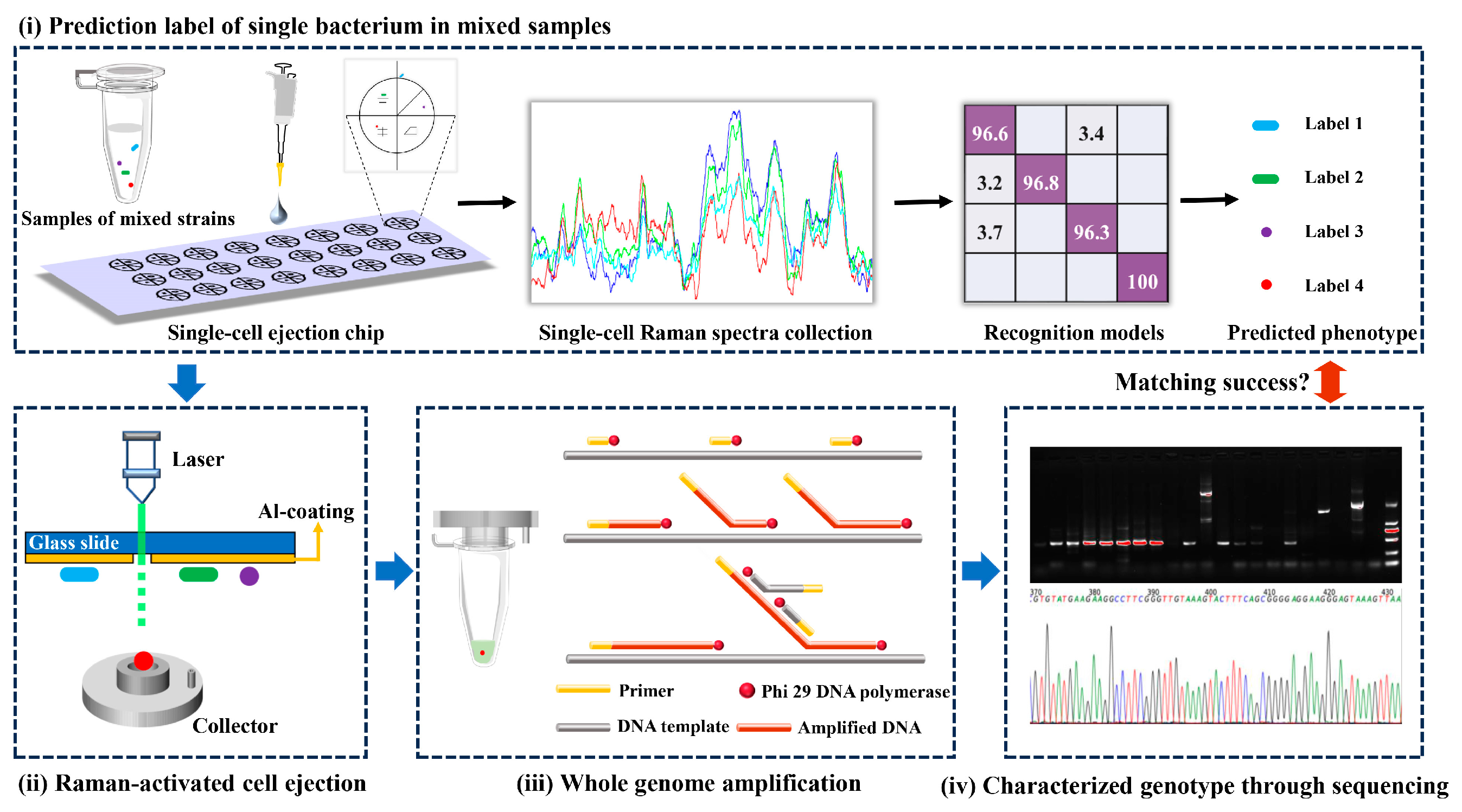
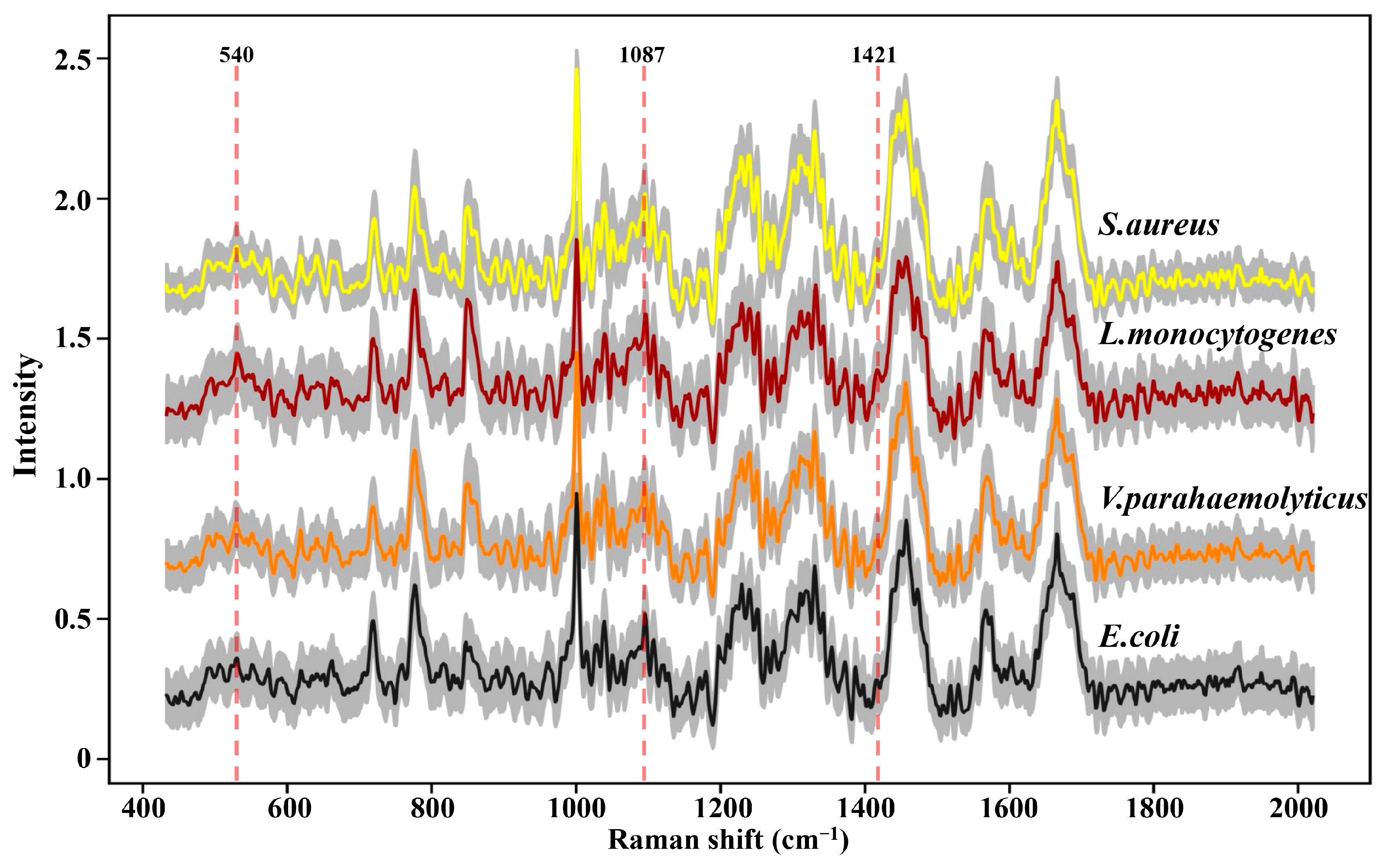
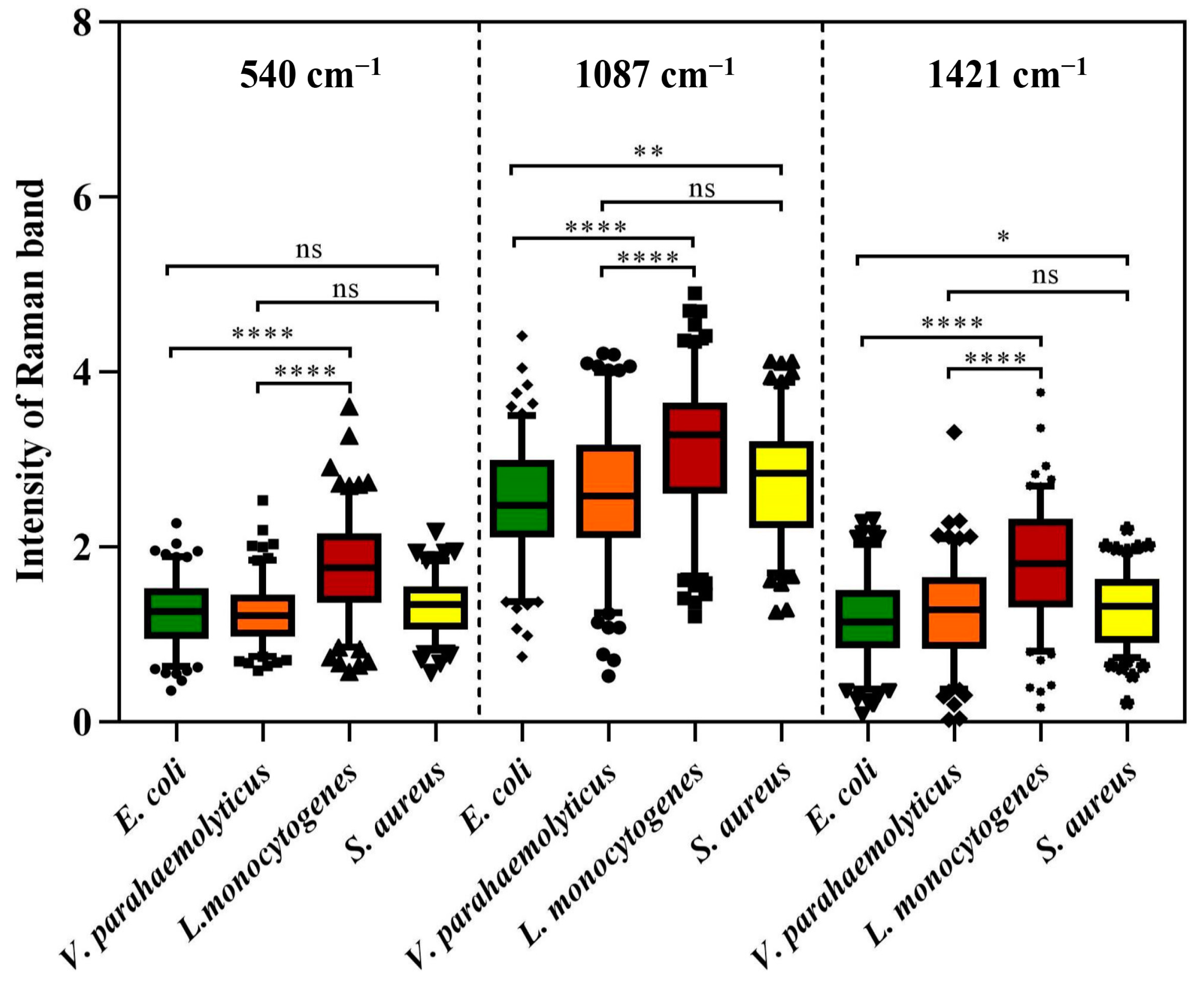


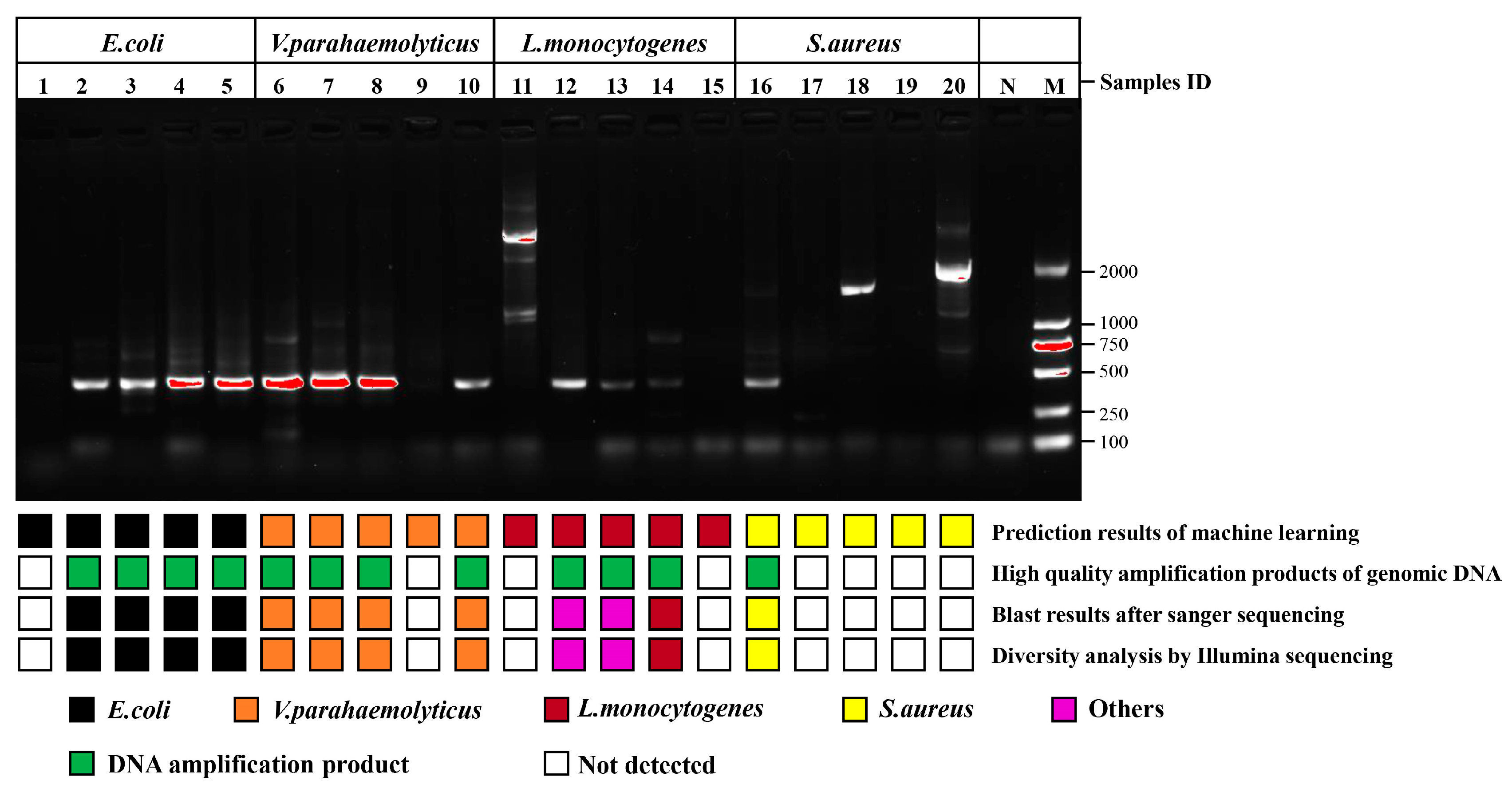
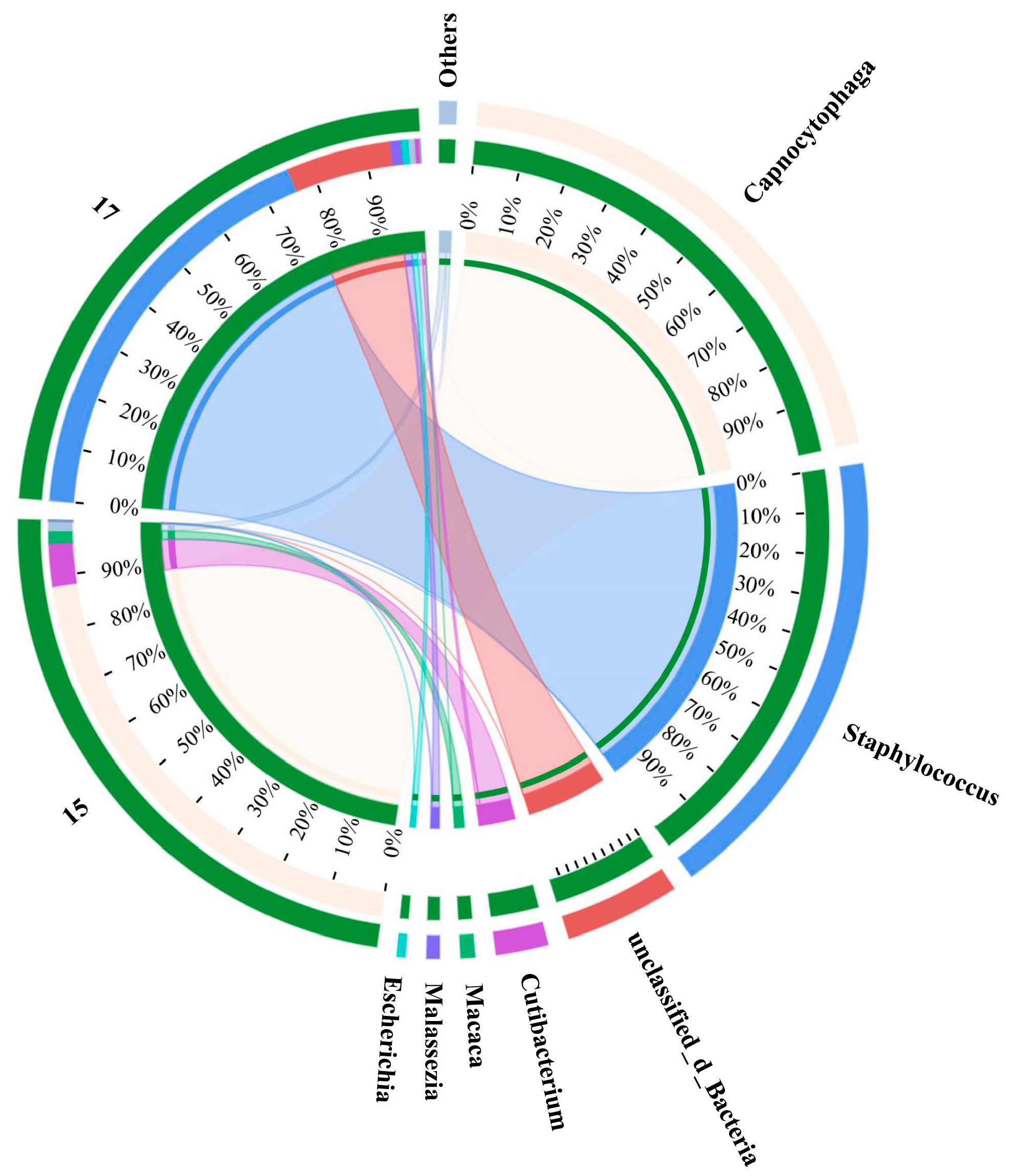
| Samples | Prediction Results of Machine Learning | Blast Sequence after Sanger Sequencing | Diversity Analysis by Illumina Sequencing |
|---|---|---|---|
| 2 | E. coli | E. coli | Escherichia |
| 3 | E. coli | E. coli | Escherichia |
| 4 | E. coli | E. coli | Escherichia |
| 5 | E. coli | E.coli | Escherichia |
| 6 | V. parahaemolyticus | V. parahaemolyticus | Vibrio |
| 7 | V. parahaemolyticus | V. parahaemolyticus | Vibrio |
| 8 | V. parahaemolyticus | V. parahaemolyticus | Vibrio |
| 10 | V. parahaemolyticus | V. parahaemolyticus | Vibrio |
| 12 | L. monocytogenes | Micrococcus luteus | Micrococcus |
| 13 | L. monocytogenes | Cutibacterium acnes | Cutibacterium |
| 14 | L. monocytogenes | L. monocytogenes | Listeria |
| 16 | S. aureus | S. aureus | Staphylococcus |
Disclaimer/Publisher’s Note: The statements, opinions and data contained in all publications are solely those of the individual author(s) and contributor(s) and not of MDPI and/or the editor(s). MDPI and/or the editor(s) disclaim responsibility for any injury to people or property resulting from any ideas, methods, instructions or products referred to in the content. |
© 2024 by the authors. Licensee MDPI, Basel, Switzerland. This article is an open access article distributed under the terms and conditions of the Creative Commons Attribution (CC BY) license (https://creativecommons.org/licenses/by/4.0/).
Share and Cite
Yan, S.; Guo, X.; Zong, Z.; Li, Y.; Li, G.; Xu, J.; Jin, C.; Liu, Q. Raman-Activated Cell Ejection for Validating the Reliability of the Raman Fingerprint Database of Foodborne Pathogens. Foods 2024, 13, 1886. https://doi.org/10.3390/foods13121886
Yan S, Guo X, Zong Z, Li Y, Li G, Xu J, Jin C, Liu Q. Raman-Activated Cell Ejection for Validating the Reliability of the Raman Fingerprint Database of Foodborne Pathogens. Foods. 2024; 13(12):1886. https://doi.org/10.3390/foods13121886
Chicago/Turabian StyleYan, Shuaishuai, Xinru Guo, Zheng Zong, Yang Li, Guoliang Li, Jianguo Xu, Chengni Jin, and Qing Liu. 2024. "Raman-Activated Cell Ejection for Validating the Reliability of the Raman Fingerprint Database of Foodborne Pathogens" Foods 13, no. 12: 1886. https://doi.org/10.3390/foods13121886
APA StyleYan, S., Guo, X., Zong, Z., Li, Y., Li, G., Xu, J., Jin, C., & Liu, Q. (2024). Raman-Activated Cell Ejection for Validating the Reliability of the Raman Fingerprint Database of Foodborne Pathogens. Foods, 13(12), 1886. https://doi.org/10.3390/foods13121886







